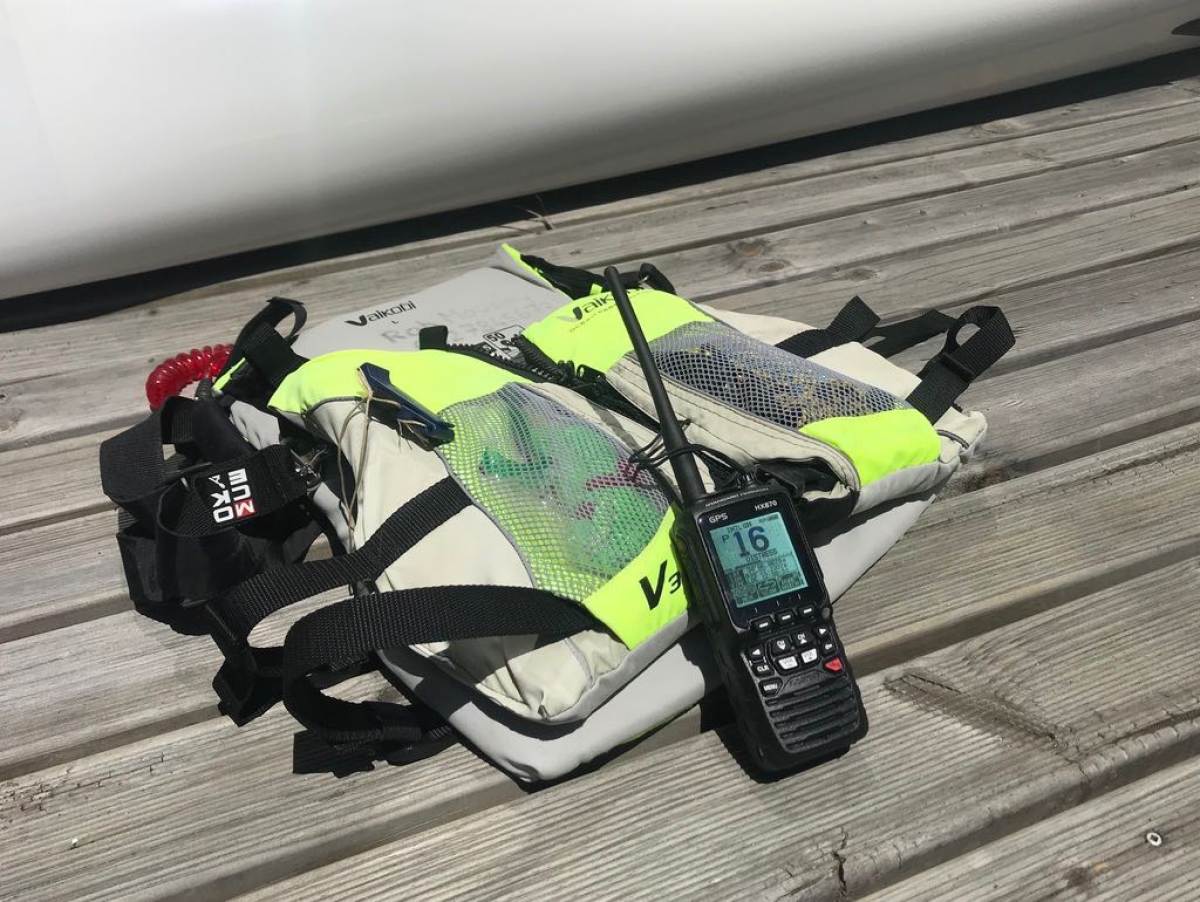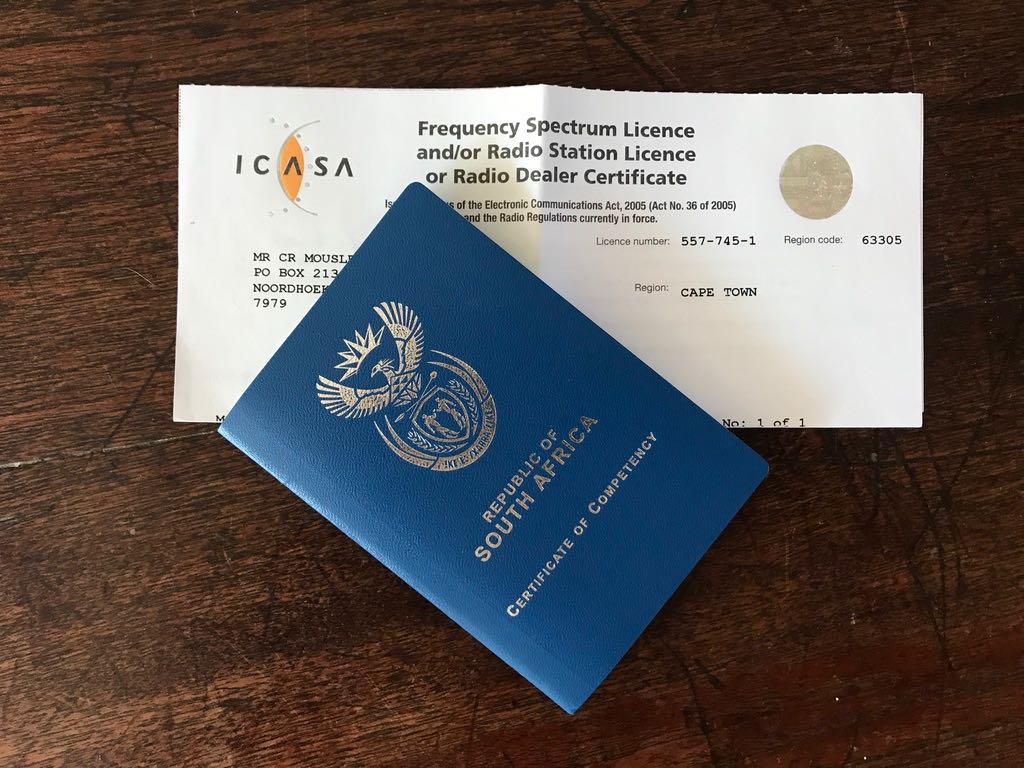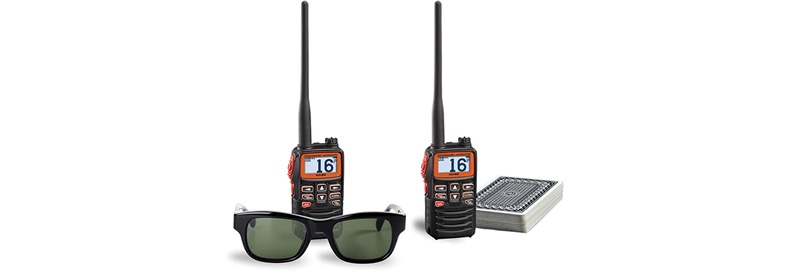Review: Standard Horizon HX870 Handheld VHF Radio - UPDATED
 The Standard Horizon HX870E Handheld VHF Radio
Credits: Rob Mousley/Surfski.info
The Standard Horizon HX870E Handheld VHF Radio
Credits: Rob Mousley/Surfski.info
Many paddlers use Personal Locator Beacons, or tracker apps like SafeTrx on their mobile phones. But handheld VHF radios are also a great choice to consider – especially when they’re DSC-capable like the Standard Horizon HX870E.
Communication at Sea
These days we have choices if we need to call for help:
- A tracker app (like SafeTrx) on your mobile is a great choice. It’s free and all you need is a waterproof pouch for your phone.
- Personal Locator Beacons are popular in some parts of the world – and they work everywhere.
- Flares are a good option too. I summoned help for a fellow paddler using pencil flares in daylight. Worked like a charm.
But all of these things have drawbacks:
- Mobile phones can be tricky to operate through a pouch, and they need a reliable GSM signal, which isn’t always available.
- PLBs have to be operated properly (the unit must be held clear of the water) and the communication is one-way – you can’t tell if someone is coming to get you.
- Pencil flares don’t last long, and smoke flares are bulky and usually you’ll only have one with you.
VHF radios, while also not a silver bullet, have some unique advantages:
- They’re really, really easy to operate – push a button to talk.
- Modern DSC-capable radios incorporate a GPS and automatically broadcast your position to vessels equipped with DSC-receivers (like the NSRI rescue boats).
Repeater Stations
Here in South Africa, the maritime authorities maintain a chain of radio repeaters along the coast, which extends the range of VHF communications.
For example, False Bay, home of the (in)famous Miller’s Run, is surrounded by mountains – and VHF signals from handheld radios are picked up by Cape Town Radio over the entire length of the Miller’s Run.
But even in areas where there isn’t the same infrastructure and the signal is limited to line-of-sight, a radio can be invaluable when talking to a nearby rescue craft. When we did our Search and Rescue exercise some years ago with the NSRI, I was astonished at how limited the field of view was out of the rescue boat.
It’s vital to be able to talk to your rescuers because you’ll most likely see them long before they see you.
Standard Horizon HX870E Marine Handheld VHF Radio
Having used a basic ICOM VHF for many years, I recently switched to the DSC-capable HX870E and have found it to be a reassuringly robust and feature-rich radio.

The HX870E has a big, bright screen that is easy to read in direct sunlight
The major differences between the HX870E and conventional VHF radios like the ICOM M36 are that the HX870E:
- Has a built in GPS receiver.
- Is DSC-capable. This means that it can send a digital message to other DSC-capable receivers, including your GPS coordinates. If you send a distress message, it will automatically activate alarms on all DSC-capable receivers.
User Interface
The big screen is bright and easy to read, while the menus are straight forward and intuitive to use.
The DSC Distress button is located to one side, with a cover to prevent accidental activation. To call for help, you simply lift the flap and press the red button for three seconds. Thereafter the radio will broadcast your status and position until it receives an acknowledgement from another DSC-capable unit.
Another advantage of DSC is that you can communicate privately over the digital channel with another DSC-capable radio without broadcasting to the world.
Other Features
A number of other features are built into this radio:
- It floats (and, it hardly need be said, it's waterproof with an IPX8 rating - to 1.5m or 4.92ft for 30 minutes)
- It has a high capacity 1,800mAh battery and comes with a rapid charger (3hr to from empty).
- On the front of the radio, there’s a programmable strobe light that switches on a automatically if the radio is submerged.
Using the Radio for Real
A couple of weeks after I published this article, I found myself in a real rescue situation when a buddy broke his paddle during a downwind run in 30-40kt - a very gnarly situation.
Here's the story:
Here's what I learnt:
- It's very different testing the radio in calm air on dry land i.e. under ideal conditions.
- On the water, sitting on a surfski in 30-40kt of wind and spray, it's extremely difficult to make yourself heard.
- If the microphone is covered with water, the result is that the person receiving your call just hears a garbled noise when you speak. You need to try to get the microphone away from the wind - e.g. tucked into the collar of your PFD - and you need to blow hard on the microphone to clear the water away from it.
- Alternatively, putting the radio in a waterproof bag will keep much of the noise out. The issue with that though, is that it makes the radio more bulky and at the moment it only just fits into the pocket of my PFD in any case. Conundrum!
- It's likely to be extremely noisy inside the rescue boat, which makes it all the more difficult for them to hear what you're saying on the radio. We ended up with the rescue commander onshore taking my directions and relaying them to the boat to guide them to our position.
There’s never a silver bullet
There’s no question – if you go offshore in any kind of vessel, you should have some means of communication.
But whatever you choose, flares, PLB, radio or mobile phone, be aware that none of them is entirely fool-proof, and ideally you should have more than one of them AND you should have a plan B in mind should they not work.
Click here for a full discussion on surfski safety gear.
Radio License
Every DSC-capable radio requires an MMSI number to be programmed into it. The MMSI is a unique 9-digit number that is the equivalent of a phone number. Not only does identify the radio, but it enables other DSC-capable transceivers to make a private call to it – in other words, you can call your buddy without everyone else in range being able to hear the conversation.
In order to acquire an MMSI, however, you must buy a radio license. In South Africa, you apply to ICASA. The cost is not great and you can buy a multi-year license at a discount.

Radio and Operator's Licenses
Operator’s License
It’s definitely worth taking a course to learn how to operate the radio. There are two parts to the course:
- Learning how to program and use the radio, including the various DSC functions
- Learning how to articulate the various types of call, including Mayday, Pan Pan and others.
Fun fact (and one that I learnt only at the course): You say either “over” to indicate that you’ve stopped speaking and the channel is open for someone else to speak or “out” to indicate that the conversation is over (from your side). But you never say “over and out”. That’s an indication to experienced radio users that you’re a clueless newbie!
You’re not likely to be asked for your radio license (at least here in South Africa), but until I’d done the course, I’d never asked Cape Town radio for a radio check… and the first time I did, I found that my radio was faulty. Who knows how long I’d been faithfully carrying it – but if I’d had to use it, I’d have had a nasty surprise.
Now I call up Cape Town Radio for a transmission check at least every month. Aside from confirming that the unit actually works, it keeps me familiar with the operation of the radio, the format of the calls and helps me to remember my call sign.
(Of course, you can always call your buddy if they have a radio to perform a check too. Whichever – it’s worth doing a regular check.)
Alternative radios
The HX870E is quite a hefty beast; it fits into the pocket of my Vaikobi PFD, but only just.

The HX870E fits handily into the pocket of my PFD. (And no, it doesn't interfere with my remount; I've done it many times!)
If you just can’t bear to have something that big, but still want a radio, check out the Standard Horizon HX40 – it’s literally the size of a pack of playing cards, but is still a powerful 6W transmitter. It doesn’t have DSC, but if you’re looking for something ultra-compact, that’s your unit.

The HX40 is a much smaller unit
Where to find out more
Click here for the global Standard Horizon website.
In South Africa:
- The HX870E sells for around R6,000. Google it.
- The HX40 goes for between R3,300 and R4,000
The course that you should take is the Short Range Certificate. There are various third-party companies that offer training. I did it over a weekend and it cost in the region of R2,000. I strongly recommend it, having a trainer there to ask questions and having buddies to practise with made it fun as well as educational.
You even get an official passport-style license book from SAMSA (after a wait). The course and license are internationally recognised.
You apply for your radio license from the ICASA website. (The website only works with the Chrome browser and is a bit of a challenge to navigate. When I did my licensing, it was a manual process, the good news – perhaps – is that it looks as though you can now do it online.)

